Democracy and the Environment: How Political Freedom Is Linked with Environmental Sustainability
Abstract
1. Introduction
“We’ll argue that there are two different ways to analyze the relation between the two concepts: on the one hand, freedom being often referred to be in competition with ecological sustainability and the imposed limits it requires and, on the other hand, the impacts in individual’s freedom due to ecological catastrophe if strict limits are not implemented.”
2. Conceptual Building Elements of the Quadruple and Quintuple Innovation Helix Frameworks: Networking Democracy and Ecology for Innovation
“The competitiveness and superiority of a knowledge system or the degree of development of a knowledge system are particularly determined by their adaptive capability and capacity to combine and integrate several and different modes of knowledge and innovation through co-opetition (cooperation and competition), co-evolution and co-specialization’, also of knowledge stock-and-flow dynamics …” (see [7,8] (p. 201); also in relation to ‘Co-Opetition’, see [9]).
“Hence, if the patterns we have observed persist, the world will be better, much better. More people will be living in democracies; they will be wealthier; and they will be enjoying all the benefits that wealth brings, probably including great improvements in public health and medical technology. But not all of us will enjoy this progress. Poverty will still be widespread, dictators will still repress, and wars will still ruin lives” [67] (p. 277).
- Given that democracies respect individual rights, environmentalists may promote and influence decisions about environmental legislation.
- Democratic governments are inherently more responsive to their citizenry, assuring a minimum level of accountability.
- Free flowing information in democracies allows for a form of political learning, including scientific arguments regarding environmental problems.
- Democratic governments are more likely to cooperate with each other insofar as international environmental agencies and treaties are concerned.
- Given that democracies are usually based on free-market economies, businesses can be subject to both environmental incentives and sanctions.
“For the Quadruple and Quintuple Innovation Helix Frameworks, democracy and ecology (environmental protection) are constituting categories, without these a Quadruple and Quintuple Helix innovation system not possible is. To elevate here to next levels, implications could be that climate (as a component and crucial category of ecology), so to say climate itself, is being integrated into understandings of democracy and quality of democracy. ‘Democracy of Climate’ (creating a ‘climate for democracy’, desirably a ‘positive climate’ for democracy), in co-creation with a ‘democracy of knowledge’ (emphasizing a co-evolution of political pluralism and a diversity of knowledge modes in innovation), are referring to new designs and performances of innovation and innovation systems, being furthermore ex-pressed in the principles, building blocks and design of Quadruple and Quintuple Innovation Helix Frameworks. Democracy enables and encourages innovation, and the ecology and cli-mate can act as drivers for further innovation” [1].
3. Empirical Analysis: Linking Political Freedom with Environmental Performance
- Political rights;
- Civil liberties;
- Freedom of the press.
4. Conclusions
“…perhaps the economic successes of non-democracies or autocracies (authoritarian and semi-authoritarian regimes) are being overestimated anyway, because autocracies are also benefitting from the knowledge production and innovation systems of democracies and semi-democracies, so in that sense autocracy is depending on democracy and the knowledge and innovation of democracy in a global system.”
Author Contributions
Funding
Data Availability Statement
Conflicts of Interest
References
- Carayannis, E.G. Democracy and the Environment Are Endangered Species, Interview with Dr. Prof. Elias Carayannis by Charlotte Koldbye. RiConfigure. Available online: http://riconfigure.eu/wp-content/uploads/2020/01/Interview-with-Elias-Carayannis_2020_Final.pdf (accessed on 28 February 2021).
- Carayannis, E.G.; Campbell, D.F.J. Democracy of climate and climate for democracy: The evolution of Quadruple and Quintuple Helix innovation systems. J. Knowl. Econ. 2021. [Google Scholar] [CrossRef]
- Pinto, J. Freedom and ecological limits. Crit. Rev. Int. Soc. Political Philos. 2018, 1–17. [Google Scholar] [CrossRef]
- Carayannis, E.G.; Barth, T.D.; Campbell, D.F.J. The Quintuple Helix Innovation Model: Global warming as a challenge and driver for innovation. J. Innov. Entrep. 2012, 1, 1–12. [Google Scholar] [CrossRef]
- Carayannis, E.G.; Grigoroudis, E.; Campbell, D.F.J.; Meissner, D.; Stamati, D. The ecosystem as helix: An exploratory theory-building study of regional co-opetitive entrepreneurial ecosystems as Quadruple/Quintuple Helix Innovation models. R D Manag. 2018, 48, 148–162. [Google Scholar]
- Carayannis, E.G.; Grigoroudis, E.; Campbell, D.F.J.; Meissner, D.; Stamati, D. ‘Mode 3’ universities and academic firms: Thinking beyond the box trans-disciplinarity and nonlinear innovation dynamics within coopetitive entrepreneurial ecosystems. Int. J. Technol. Manag. 2018, 77, 145–185. [Google Scholar] [CrossRef]
- Carayannis, E.G. The Strategic Management of Technological Learning: Learning to Learn and Learning to Learn-How-To-Learn as Drivers of Strategic Choice and Firm Performance in Global, Technology-Driven-Markets; CRC Press: Boca Raton, FL, USA, 2001. [Google Scholar]
- Carayannis, E.G.; Campbell, D.F.J. “Mode 3” and “Quadruple Helix”: Toward a 21st century fractal innovation ecosystem. Int. J. Technol. Manag. 2009, 46, 201–234. [Google Scholar] [CrossRef]
- Brandenburger, A.M.; Nalebuff, B.J. Co-Opetition, 1st ed.; Currency Doubleday: New York, NY, USA, 1997. [Google Scholar]
- Carayannis, E.G.; Campbell, D.F.J. Smart Quintuple Helix Innovation Systems: How Social Ecology and Environmental Protection Are Driving Innovation, Sustainable Development and Economic Growth; SpringerBriefs in Business; Springer: New York, NY, USA, 2019. [Google Scholar]
- Carayannis, E.G.; Campbell, D.F.J. Mode 3 Knowledge Production in Quadruple Helix Innovation Systems: 21st-Century Democracy, Innovation, and Entrepreneurship for Development; Springer Briefs in Business; Springer: New York, NY, USA, 2012. [Google Scholar]
- Etzkowitz, H.; Leydesdorff, L. The dynamics of innovation: From national systems and “Mode 2” to a Triple Helix of university-industry-government relations. Res. Policy 2000, 29, 109–123. [Google Scholar] [CrossRef]
- Cai, Y.; Lattu, A. Synergy Building between Triple Helix and Quadruple Helix; Faculty of Management and Business, University of Tampere: Tampere, Finland, 2020. [Google Scholar]
- Carayannis, E.G.; Campbell, D.F.J. Triple Helix, Quadruple Helix and Quintuple Helix and how do knowledge, innovation and the environment relate to each other? A proposed framework for a trans-disciplinary analysis of sustainable development and social ecology. Int. J. Soc. Ecol. Sust. Dev. 2010, 1, 41–69. [Google Scholar] [CrossRef]
- Carayannis, E.G.; Campbell, D.F.J. Developed democracies versus emerging autocracies: Arts, democracy, and innovation in Quadruple Helix Innovation Systems. J. Innov. Entrep. 2014, 3, 1–23. [Google Scholar] [CrossRef]
- Carayannis, E.G.; Pirzadeh, A. The Knowledge of Culture and the Culture of Knowledge. Implications for Theory, Policy and Practice; Palgrave Macmillan: London, UK, 2014. [Google Scholar]
- Carayannis, E.G.; Christodoulou, K.; Christodoulou, P.; Chatzichristofis, S.A.; Zinonos, Z. Known unknowns in an era of technological and viral disruptions: Implications for theory, policy, and practice. J. Knowl. Econ. 2021. [Google Scholar] [CrossRef]
- Carayannis, E.G.; Dezi, L.; Gregori, G.; Calo, E. Smart environments and techno-centric and human-centric innovations for Industry and Society 5.0: A Quintuple Helix Innovation System view towards smart, sustainable, and inclusive solutions. J. Knowl. Econ. 2021. [Google Scholar] [CrossRef]
- Campbell, D.F.J.; Carayannis, E.G. The academic firm: A new design and redesign proposition for entrepreneurship in innovation-driven knowledge economy. J. Innov. Entrep. 2016, 5, 1–10. [Google Scholar] [CrossRef]
- Campbell, D.F.J.; Carayannis, E.G.; Bast, G. Conclusion: The future of the future of education and labor. In The Future of Education and Labor; Bast, G., Carayannis, E.G., Campbell, D.F.J., Eds.; Springer: New York, NY, USA, 2019; pp. 245–253. [Google Scholar]
- Bast, G.; Carayannis, E.G.; Campbell, D.F.J. (Eds.) Arts, Research, Innovation and Society; Springer: New York, NY, USA, 2015. [Google Scholar]
- Bast, G.; Carayannis, E.G.; Campbell, D.F.J. (Eds.) The Future of Education and Labor; Springer: New York, NY, USA, 2019. [Google Scholar]
- Danilda, I.; Lindberg, M.; Torstensson, B.M. Women Resource Centres: A Quattro Helix Innovation System on the European agenda. In Proceedings of the Triple Helix VII: 7th Biennial International Conference on University, Industry & Government Linkages, Glasgow, UK, 17–19 June 2009. [Google Scholar]
- De Oliveira Monteiro, S.P.; Carayannis, E.G. (Eds.) The Quadruple Innovation Helix Nexus. A Smart Growth Model, Quantitative Empirical Validation and Operationalization for OECD Countries; Palgrave Macmillan: New York, NY, USA, 2017. [Google Scholar]
- Eigelsreiter, B. Consumerization of IT, cyber-democracy and cyber-crime: The inherent challenges and opportunities of different ends of a continuum. In Handbook of Cyber-Development, Cyber-Democracy, and Cyber-Defense; Carayannis, E.G., Campbell, D.F.J., Efthymiopoulos, M.P., Eds.; Springer: New York, NY, USA, 2018; pp. 565–594. [Google Scholar]
- Hemlin, S.; Allwood, C.M.; Martin, B.R. Creative Knowledge Environments. The Influences on Creativity in Research and Innovation; Edward Elgar Publishing: Cheltenham, UK, 2004. [Google Scholar]
- Mitterlehner, B. Cyber-Democracy and cybercrime: Two sides of the same coin. In Cyber-Development, Cyber-Democracy and Cyber-Defense: Challenges, Opportunities and Implications for Theory, Policy and Practice; Carayannis, E.G., Campbell, D.F.J., Efthymiopoulos, M.P., Eds.; Springer: New York, NY, USA, 2014; pp. 207–230. [Google Scholar]
- Galan, M.; Campbell, D.F.J.; Carayannis, E.G. The role of Information and Communication Technology (ICT) in the governance of energy access: Exploring application of Quadruple and Quintuple Helix Innovation theory in technology transfer. In Handbook of Cyber-Development, Cyber-Democracy, and Cyber-Defense; Carayannis, E.G., Campbell, D.F.J., Efthymiopoulos, M.P., Eds.; Springer: New York, NY, USA, 2018; pp. 59–85. [Google Scholar]
- Fischer-Kowalski, M.; Haberl, H. (Eds.) Socioecological Transitions and Global Change: Trajectories of Social Metabolism and Land Use; Edward Elgar: Cheltenham, UK, 2007. [Google Scholar]
- European Commission. The World in 2025: Rising Asia and Socio-Ecological Transition; European Commission: Brussels, Belgium, 2009. [Google Scholar]
- Polanyi, M. The republic of science: Its political and economic theory. Minerva 1962, 1, 54–74. [Google Scholar] [CrossRef]
- Von Hippel, E. The Sources of Innovation; Oxford University Press: Oxford, UK, 1995. [Google Scholar]
- Von Hippel, E. Democratizing Innovation; The MIT Press: Cambridge, MA, USA, 2005. [Google Scholar]
- O’Donnell, G. Why the rule of law matters. J. Democr. 2004, 15, 32–46. [Google Scholar] [CrossRef]
- O’Donnell, G. Human development, human rights, and democracy. In The Quality of Democracy: Theory and Applications; O’Donnell, G., Cullell., J.V., Iazzetta, O.M., Eds.; University of Notre Dame Press: Notre Dame, IN, USA, 2004; pp. 9–92. [Google Scholar]
- Sen, A. Development as Freedom; Anchor Book: New York, NY, USA, 1999. [Google Scholar]
- Sen, A. Human rights and capabilities. J. Hum. Dev. 2005, 6, 151–166. [Google Scholar] [CrossRef]
- Beetham, D. Key principles and indices for a democratic audit. In Defining and Measuring Democracy; Beetham, D., Ed.; Sage: London, UK, 1994; pp. 25–43. [Google Scholar]
- Beetham, D. (Ed.) Defining and Measuring Democracy; Sage: London, UK, 1994. [Google Scholar]
- Beetham, D. Freedom as the foundation. J. Democr. 2004, 15, 61–75. [Google Scholar] [CrossRef]
- Bühlmann, M.; Merkel, W.; Müller, L.; Weßels, B. The democracy barometer: A new instrument to measure the quality of democracy and its potential for comparative research. Eur. Political Sci. 2011, 11, 519–536. [Google Scholar] [CrossRef]
- Coppedgea, M.; Gerring, J.; Altman, D.; Bernhard, M.; Fish, S.; Hicken, A.; Kroenig, M.; Lindberg, S.I.; McMann, K.; Paxton, P.; et al. Conceptualizing and measuring democracy: A new approach. Perspect. Polit. 2011, 9, 247–267. [Google Scholar] [CrossRef]
- Cullel, J.V. Democracy and the quality of democracy: Empirical findings and methodological and theoretical issues drawn from the citizen audit of the quality of democracy in Costa Rica. In The Quality of Democracy: Theory and Applications; O’Donnell, G., Cullell, J.V., Iazzetta, O.M., Eds.; University of Notre Dame Press: Notre Dame, IN, USA, 2004; pp. 93–162. [Google Scholar]
- Diamond, L.; Morlino, L. The quality of democracy: An overview. J. Democr. 2004, 15, 20–31. [Google Scholar] [CrossRef]
- Diamond, L.; Morlino, L. Assessing the Quality of Democracy; The Johns Hopkins University Press: Baltimore, MA, USA, 2005. [Google Scholar]
- Geissel, B.; Kneuer, M.; Lauth, H.J. Measuring the quality of democracy: Introduction. Int. Political Sci. Rev. 2016, 37, 571–579. [Google Scholar] [CrossRef]
- Helms, L. Die Institutionalisierung der Liberalen Demokratie: Deutschland im Internationalen Vergleich; Campus Verlag: Frankfurt, Germany, 2007. [Google Scholar]
- Munck, G.L. What is democracy? A reconceptualization of the quality of democracy. Democratization 2016, 23, 1–26. [Google Scholar] [CrossRef]
- Munck, G.L.; Verkuilen, J. Conceptualizing and measuring democracy: Evaluating alternative indices. Comp. Political Stud. 2002, 35, 5–34. [Google Scholar] [CrossRef]
- Schmidt, M.G. Demokratietheorien: Eine Einführung; VS Verlag für Sozialwissenschaften: Wiesbaden, Germany, 2010. [Google Scholar]
- Campbell, D.F.J. The Basic Concept for the Democracy Ranking of the Quality of Democracy; Democracy Ranking: Vienna, Austria, 2008. [Google Scholar]
- Campbell, D.F.J.; Barth, T.D. Wie können Demokratie und Demokratiequalität gemessen werden? Modelle, Demokratie-Indices und Länderbeispiele im globalen Vergleich. SWS-Rundschau 2009, 49, 208–233. [Google Scholar]
- Campbell, D.F.J.; Carayannis, E.G.; Barth, T.D.; Campbell, G.S. Measuring democracy and the quality of democracy in a world-wide approach: Models and indices of democracy and the new findings of the “Democracy Ranking”. Int. J. Soc. Ecol. Sust. Dev. 2013, 4, 1–16. [Google Scholar] [CrossRef]
- De Roeck, M.; Van Rossem, R. Fifty Shades of Grey? Conceptualizing and Measuring Political Regimes Using Theories of Democracy; 1972–2010, Working Paper 2015.05; University of Antwerp: Antwerpen, Belgium, 2015. [Google Scholar]
- Downs, A. An Economic Theory of Democracy; Harper: New York, NY, USA, 1957. [Google Scholar]
- Freedom House Freedom in the World: Aggregate Scores of Political Rights and Civil Liberties 2003–2013; Freedom House: Washington, DC, USA, 2013; Available online: http://www.freedomhouse.org/sites/default/files/AggregateScores_FIW2003-2013%20%28final%29.xls (accessed on 28 February 2021).
- Inkeles, A. (Ed.) On Measuring Democracy: Its Consequences and Concomitants; Transaction Publishers: New Brunswick, NJ, USA, 1993. [Google Scholar]
- Prainsack, B. Vom Wert des Menschen: Warum wir ein Bedingungsloses Grundeinkommen Brauchen; Brandstätter Verlag: Vienna, Austria, 2020. [Google Scholar]
- Brand, U.; Brunnengräber, A.; Schrader, L. Global Governance: Alternative zur Neoliberalen Globalisierung; Westfälisches Dampfboot: Münster, Germany, 2000. [Google Scholar]
- Brand, U.; Wissen, M. Imperiale Lebensweise: Zur Ausbeutung von Mensch und Natur in Zeiten des Globalen Kapitalismus; Oekom Verlag: Munich, Germany, 2017. [Google Scholar]
- Gerring, J.; Bond, P.; Barndt, W.T.; Moreno, C. Democracy and economic growth: A historical perspective. World Politics 2005, 57, 323–364. [Google Scholar] [CrossRef]
- Hadenius, A.; Teorell, J. Cultural and economic prerequisites of democracy: Reassessing recent evidence. Stud. Comp. Int. Dev. 2005, 39, 87–106. [Google Scholar] [CrossRef]
- Kesselman, M. Order or movement? The literature of political development as ideology. World Politics 1973, 26, 139–154. [Google Scholar] [CrossRef]
- Knutsen, C.H. Democracy and economic growth: A survey of arguments and results. Int. Area Stud. Rev. 2012, 15, 393–415. [Google Scholar] [CrossRef]
- Merkel, W. Das Ende der Euphorie: Kehren die Diktaturen zurück? Theoretische und empirische Befunde. WZB-Mitteilungen 2010, 127, 36–39. [Google Scholar]
- Morlino, L.; Quaranta, M. What is the impact of the economic crisis on democracy? Evidence from Europa. Int. Political Sci. Rev. 2016, 37, 618–633. [Google Scholar] [CrossRef]
- Przeworski, A.; Alvarez, M.E.; Cheibub, J.A.; Limongi, F. Democracy and Development: Political Institutions and Well-Being in the World 1950–1990; Cambridge University Press: Cambridge, UK, 2003. [Google Scholar]
- Rothstein, B.; Uslaner, E.M. All for all: Equality, corruption, and social trust. World Politics 2005, 58, 41–72. [Google Scholar] [CrossRef]
- Midlarsky, M.I. Democracy and the environment: An empirical assessment. J. Peace Res. 1998, 35, 341–361. [Google Scholar] [CrossRef]
- Lauth, H.J. Demokratie und Demokratiemessung. Eine Konzeptionelle Grundlegung für den Interkulturellen Vergleich; VS Verlag für Sozialwissenschaften: Wiesbaden, Germany, 2004. [Google Scholar]
- Lauth, H.J. Möglichkeiten und Grenzen der Demokratiemessung. Z. Staats Eur. 2010, 8, 498–529. [Google Scholar] [CrossRef]
- Lauth, H.J. Qualitative Ansätze der Demokratiemessung. Z. Staats Eur. 2011, 9, 49–77. [Google Scholar] [CrossRef]
- Lauth, H.J. The Internal relationships of the dimensions of democracy: The relevance of trade-offs for measuring the quality of democracy. Int. Political Sci. Rev. 2016, 37, 606–617. [Google Scholar] [CrossRef]
- Lauth, H.J.; Schlenkrich, O. Making trade-offs visible: Theoretical and methodological considerations about the relationship between dimensions and institutions of democracy and empirical findings. Politics Gov. 2018, 6, 78–91. [Google Scholar] [CrossRef]
- Bohman, J.; Rehg, W. (Eds.) Deliberative Democracy. Essays on Reason and Politics; MIT Press: Cambridge, MA, USA, 1997. [Google Scholar]
- Campbell, D.F.J. Die österreichische Demokratiequalität in Perspektive. In Die Österreichische Demokratie im Vergleich; Helms, L., Wineroither, D.M., Eds.; Nomos: Baden-Baden, Germany, 2012; pp. 293–315. [Google Scholar]
- Campbell, D.F.J. Global Quality of Democracy as Innovation Enabler. Measuring Democracy for Success; Palgrave Macmillan: New York, NY, USA, 2019. [Google Scholar]
- Campbell, D.F.J.; Carayannis, E.G.; Rehman, S.S. Quadruple helix structures of quality of democracy in innovation systems: The USA, OECD countries, and EU member countries in global comparison. J. Knowl. Econ. 2015, 6, 467–493. [Google Scholar] [CrossRef]
- Campbell, D.F.J.; Carayannis, E.G. Quality of democracy and innovation. In Encyclopedia of Creativity, Invention, Innovation and Entrepreneurship; Carayannis, E.G., Ed.; Springer: New York, NY, USA, 2013; pp. 1527–1534. [Google Scholar]
- Hanusch, F. Democracy and Climate Change; Routledge: London, UK, 2018. [Google Scholar]
- Deese, R.S. Climate Change and the Future of Democracy; Springer: Cham, Switzerland, 2019. [Google Scholar]
- Campbell, G.S.; Campbell, D.F.J. The semi-aquatic theory: Semi-aquatic evolutionary phase and environment, language development of modern humans, with a short epilog on conceptualized evolution, social ecology and the Quintuple Helix. Int. J. Soc. Ecol. Sust. Dev. 2011, 2, 15–30. [Google Scholar] [CrossRef][Green Version]
- Obama, B. The irreversible momentum of clean energy. Science 2017, 355, 126–129. [Google Scholar] [CrossRef] [PubMed]
- Freedom House Freedom in the World: Aggregate and Subcategory Scores; Freedom House: Washington, DC, USA, 2016; Available online: https://freedomhouse.org/report/freedom-world (accessed on 28 February 2021).
- Freedom House Freedom of the Press: The Historical Freedom of the Press Data; Freedom House: Washington, DC, USA, 2016; Available online: https://freedomhouse.org/report-types/freedom-press (accessed on 28 February 2021).
- World Bank Climate Change Knowledge Portal; World Bank: Washington, DC, USA, 2021; Available online: https://climateknowledgeportal.worldbank.org/download-data (accessed on 28 February 2021).
- Hsu, A.; Esty, D.; Levy, M.; de Sherbinin, A. The 2016 Environmental Performance Index Report; Yale Center for Environmental Law and Policy: New Haven, CT, USA, 2016. [Google Scholar] [CrossRef]
- Yale Center for Environmental Law and Policy (YCELP, Yale University); Yale Data-Driven Environmental Solutions Group (Yale University); Center for International Earth Science Information Network (CIESIN, Columbia University). World Economic Forum (WEF) 2016 Environmental Performance Index (EPI); NASA Socioeconomic Data and Applications Center (SEDAC): Palisades, NY, USA, 2016; Available online: https://sedac.ciesin.columbia.edu/data/set/epi-environmental-performance-index-2016/data-download (accessed on 28 February 2021).
- Simon, H. Spurious correlation: A causal interpretation. J. Am. Stat. Assoc. 1954, 49, 467–479. [Google Scholar]
- Povitkina, M. The limits of democracy in tackling climate change. Environ. Polit. 2018, 27, 411–432. [Google Scholar] [CrossRef]
- Dasgupta, S.; De Cian, E. The influence of institutions, governance, and public opinion on the environment: Synthesized findings from applied econometrics studies. Energ. Res. Soc. Sci. 2018, 42, 77–95. [Google Scholar] [CrossRef]
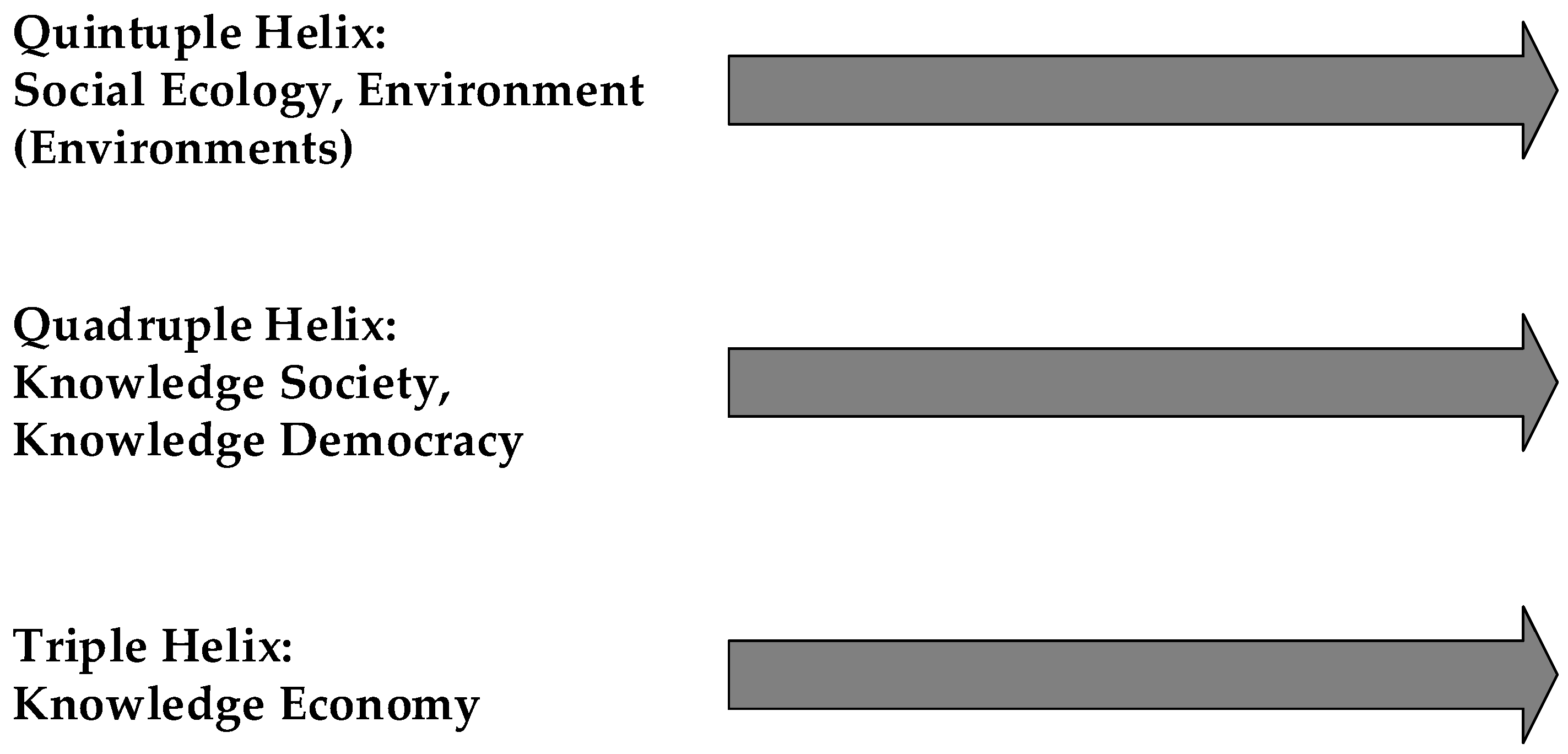
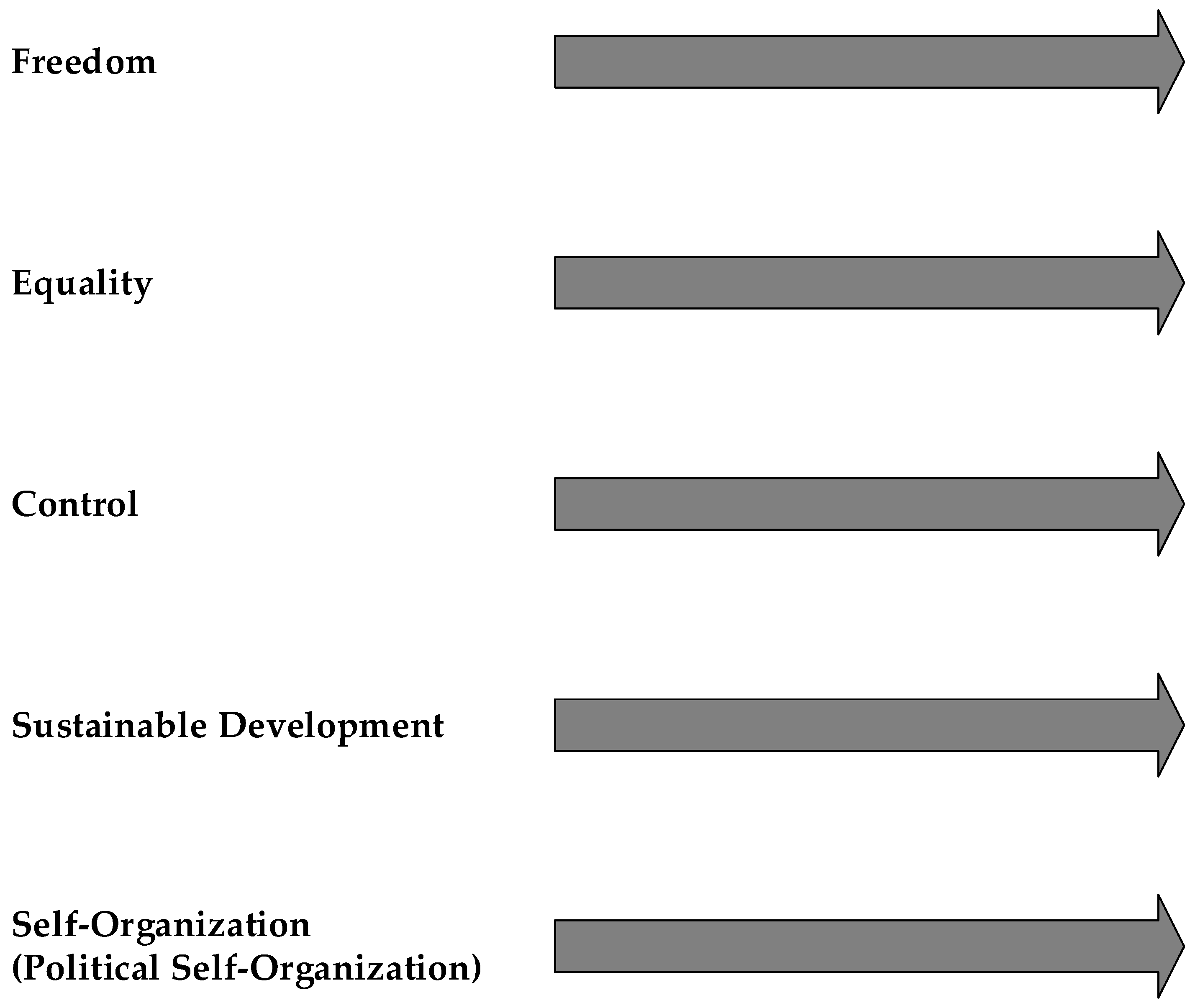
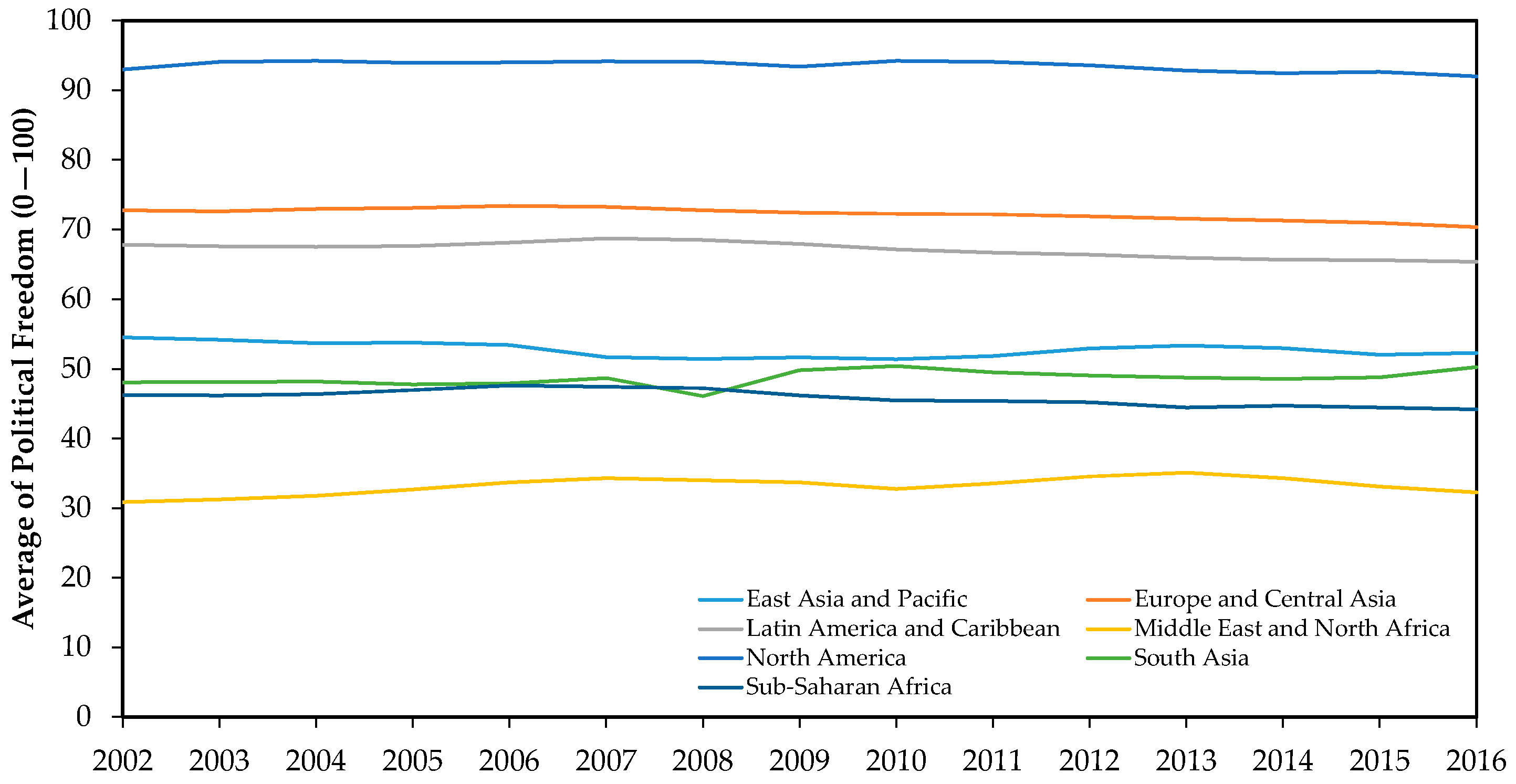
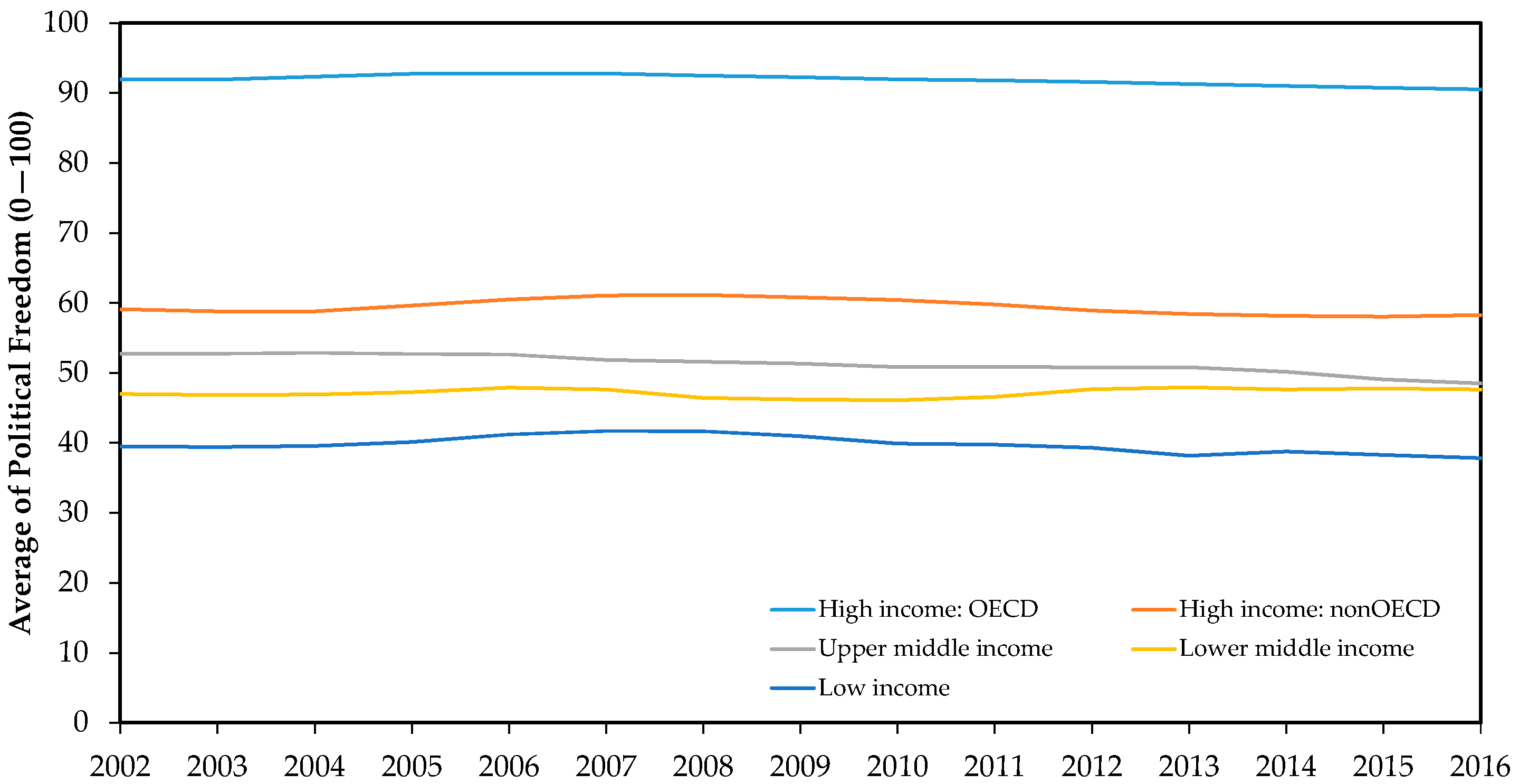
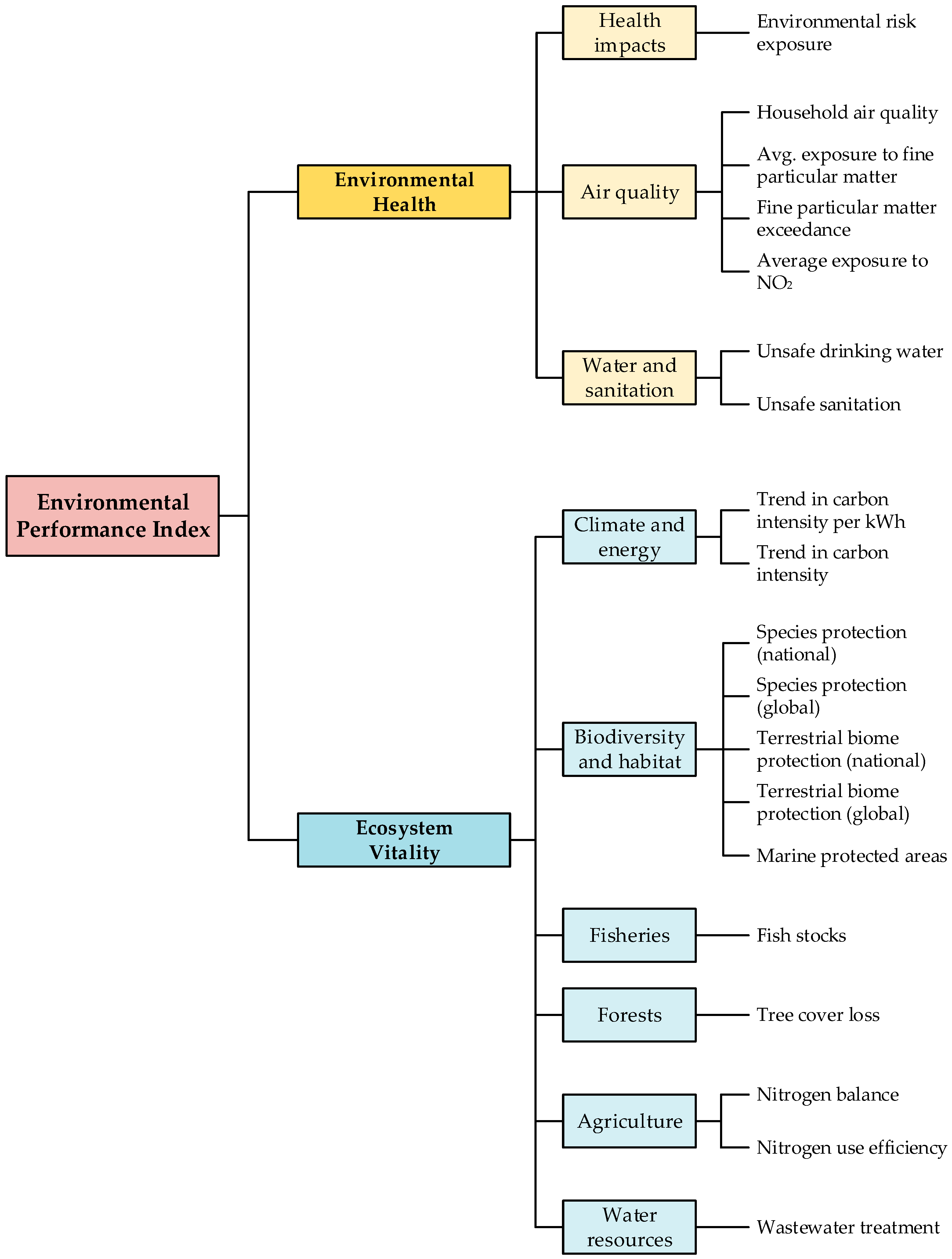
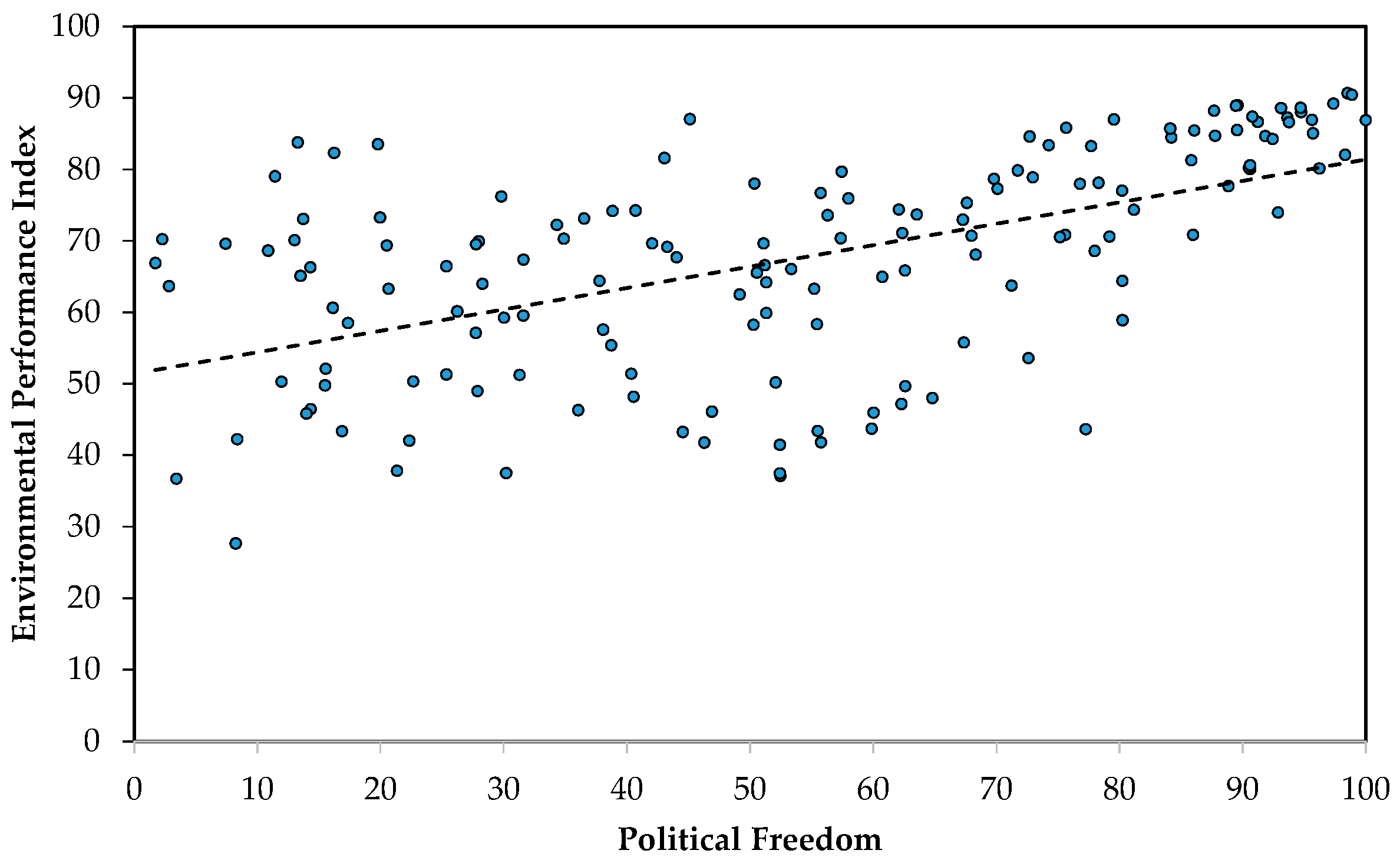
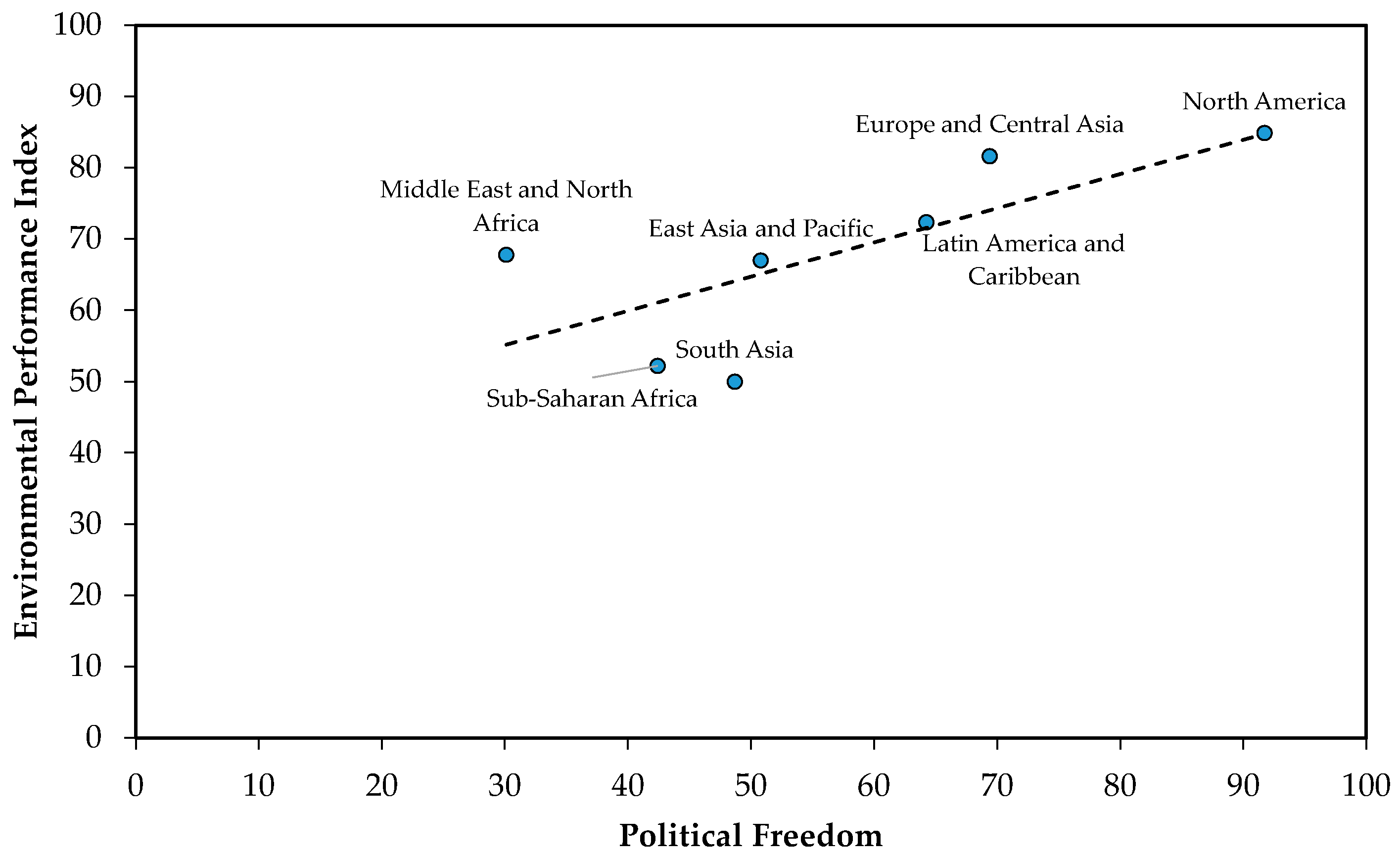
| Geographical Area | Political Freedom Score 1 | Environmental Performance Index 1 |
|---|---|---|
| East Asia and Pacific | 50.778 | 67.005 |
| Europe and Central Asia | 69.391 | 81.639 |
| Latin America and Caribbean | 64.259 | 72.360 |
| Middle East and North Africa | 30.113 | 67.807 |
| North America | 91.724 | 84.890 |
| South Asia | 48.685 | 50.005 |
| Sub-Saharan Africa | 42.414 | 52.213 |
| Geographical Area | Political Freedom Score 1 | Environmental Performance Index 1 |
|---|---|---|
| High income: OECD | 90.215 | 85.112 |
| High income: non OECD | 56.938 | 74.889 |
| Upper middle income | 46.864 | 73.209 |
| Lower middle income | 45.957 | 60.759 |
| Low income | 35.864 | 47.613 |
Publisher’s Note: MDPI stays neutral with regard to jurisdictional claims in published maps and institutional affiliations. |
© 2021 by the authors. Licensee MDPI, Basel, Switzerland. This article is an open access article distributed under the terms and conditions of the Creative Commons Attribution (CC BY) license (https://creativecommons.org/licenses/by/4.0/).
Share and Cite
Carayannis, E.G.; Campbell, D.F.J.; Grigoroudis, E. Democracy and the Environment: How Political Freedom Is Linked with Environmental Sustainability. Sustainability 2021, 13, 5522. https://doi.org/10.3390/su13105522
Carayannis EG, Campbell DFJ, Grigoroudis E. Democracy and the Environment: How Political Freedom Is Linked with Environmental Sustainability. Sustainability. 2021; 13(10):5522. https://doi.org/10.3390/su13105522
Chicago/Turabian StyleCarayannis, Elias G., David F. J. Campbell, and Evangelos Grigoroudis. 2021. "Democracy and the Environment: How Political Freedom Is Linked with Environmental Sustainability" Sustainability 13, no. 10: 5522. https://doi.org/10.3390/su13105522
APA StyleCarayannis, E. G., Campbell, D. F. J., & Grigoroudis, E. (2021). Democracy and the Environment: How Political Freedom Is Linked with Environmental Sustainability. Sustainability, 13(10), 5522. https://doi.org/10.3390/su13105522








